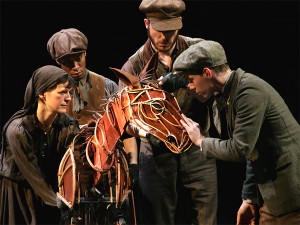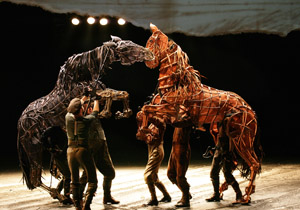Often, I think, we want to set our sleepy lives on fire.
Many of us live in our routines. Take out the dog, gobble breakfast, mindfully ignore the traffic driving to work, engage with our tasks, banter with our co-workers, glide home, take out the dog, kiss the spouse, try to pry out the kids’ stories, eat, drink a beer, sip wine, spend an hour or two gazing at some kind of screen, take out the dog, collapse, do over. That list may provide room for mystery and romance, for the shock of the new, the ache of love, wild laughter, the comfort of quiet talk, and even surges of vitality, but it also has a sleepwalker’s pace in its regularity. How often do we see ourselves as men and women who act heroically or who confront life? Routines are passive by their very nature, and thus our perception of our lives as unheroic, irresolute, still. Even my 17 and 18 year old seniors had begun to adopt this point of view – “My life is dull. Nothing ever happens. I never do anything.”
I don’t agree with this analysis. I have seen plenty of drama and conflict and high emotions in the interstices of a routine life, if that term even makes sense. However, taking Butch or Billy out again, to do his business again, and eating that casserole half asleep again … well, we all have walked that path, and thus we yearn for stories to take us over for a while and lift our timidity from us.
The most direct kind of story I know of is found on a stage in front of a live audience. If we are fortunate, we may attend a performance constructed by a good writer and skilled actors, one further improved by imaginative designs of sound and light and scenery, and one directed by an artist able to draw all of the collaborators together and attend to one coherent vision. If all of these factors converge, in the midst of the performance, seated in the darkness with all those other sleepwalkers, we may feel the heat on our skins and momentarily our lives may burst into flame.
Now, leave that last metaphor behind. Become an empiricist for a moment. Douse the romance. What happens on stage? What do we see? What do we make of what we see? Something marvelous does happen up there, and there is mystery involved in its alchemy, but the mystery of theater is not why we believe but what do we believe.
We do not fall victim to a progressive lunacy upon sitting down in our seats. We do not emerge from a psychotic dream when the actors leave and the lights come up, able once again to pay the parking fee and find our way home. Then again, something transformative does happen in that darkness.
 For example, in the play War Horse we begin with a bare wooden stage, gray-brown, scratched and showing drag lines. Suspended above the stage, a cloud constructed out of canvas, about 40 feet long, made to resemble a torn shred of paper from a drawing pad. Charcoal animations of landscapes and actions are projected onto this throughout the play. We look onto the stage and take note of how a version of reality will be suggested.
For example, in the play War Horse we begin with a bare wooden stage, gray-brown, scratched and showing drag lines. Suspended above the stage, a cloud constructed out of canvas, about 40 feet long, made to resemble a torn shred of paper from a drawing pad. Charcoal animations of landscapes and actions are projected onto this throughout the play. We look onto the stage and take note of how a version of reality will be suggested.
We first see Joey, the central protagonist, as a foal. He is an elaborate puppet. Three actors control his movements. Two stand next to him and one behind. They are costumed as workers might have dressed at the time, 1912. Later, in a lovely piece of stagecraft, we see Joey as a full stallion seem to emerge from Joey the foal. Three actors also control his mvements, two within the puppet and one at the side of the head. In every action we see Joey and every other puppet horse in the play manipulated by puppeteers.
The puppeteers’ skills are a part of the transformation we experience. They have obviously watched horses for a long time. Joey’s exhalation of breath as he extends his neck, a game he plays with Albert, the boy who loves him, is spot on realistic. His ungainly, enthusiastic runs, the twitching of his ears and shaking of his head, the flutter of his tail, his uncertainty at times as shown in the hesitating lurch of his front legs – all of these resemble a real foal in the real world. Even standing still, his handlers can induce the trembling, rippling skin that we have all seen in real horses. Our appreciation of the dexterity and proficiency of Joey’s handlers begins to slide into something more, an appreciation of Joey.
 Stop now, and read the last sentence carefully. Joey moved from object to subject, from a thing led by others to a … what?… a not-quite-thing?, to a creature-thing? You choose the word, but we were set up for the change in our reaction to him from the first by his name, Joey, by the very act of naming a thing, by the long o and the elongation of the ey – Jooooooeeeee. Some theatrical spirit moves us all together. All together we sit in the darkness and look into the light, the wonderful songs of the play lock all of us into melodies, we see Joey romp and play and charge in superb imitation of a real horse, we see Albert’s expressive, intense love of Joey, the puppet who moves like a horse, and then, suddenly, the puppeteers do not matter. We always see them. We do not make a leap of faith toward disbelief. We make the leap to “I don’t give a damn what I see. I will follow the story and believe in the story.” The heart leads and the head follows.
Stop now, and read the last sentence carefully. Joey moved from object to subject, from a thing led by others to a … what?… a not-quite-thing?, to a creature-thing? You choose the word, but we were set up for the change in our reaction to him from the first by his name, Joey, by the very act of naming a thing, by the long o and the elongation of the ey – Jooooooeeeee. Some theatrical spirit moves us all together. All together we sit in the darkness and look into the light, the wonderful songs of the play lock all of us into melodies, we see Joey romp and play and charge in superb imitation of a real horse, we see Albert’s expressive, intense love of Joey, the puppet who moves like a horse, and then, suddenly, the puppeteers do not matter. We always see them. We do not make a leap of faith toward disbelief. We make the leap to “I don’t give a damn what I see. I will follow the story and believe in the story.” The heart leads and the head follows.
We believe in the emotions because we know that love, loyalty and playfulness, the nobility of horses and the devotion of lovers of horses are all real. We are also drawn into this story because the central figure is a horse, an animal with which we have become intimate, an animal like dogs and cats, elephants, the raptors, whales, and some primates, onto whom we have projected our moral values. Horses have been our companions for 7000 years; they respond to us as individuals. In a sense their lives grow inside our lives. We have taken them into our hearts. The creators of Joey had all of this on their side before the play begins. They could tap into our memories of horses, our images recollected from movies and personal experience. We superimpose the figures moving in our heads onto the figure of Joey, and onto the characters and actions we see on the stage. Good plays must always be greater than the sum of their parts.
War Horse depends upon a visceral interplay of image and music to summon our charged emotions. For example, when Captain Stewart dies in a frontal assault on German machine guns, we are battered by strobe lights and the terrible, smashing sounds of explosions and firing. Stewart is physically lifted from his saddle and carried backward, an unmoving tableau of a cavalry officer caught in the moment of his death, saber raised, until he vanishes offstage. In another striking moment, 5 grievously wounded men struggling to climb the gangplank of a boat in one beating moment come to suggest the unconscionable waste of the war.
In the darkness, strangers all, we become a communal people privileged to enter a story shown to us in real time, in front of us. We pay to be authentically moved. Entranced by the spectacle, by the connecting influences of our imaginations, and by our own capacity for depth of feeling, all together, we exalt the interplay of things and actors, and thus give ourselves over to their power. All together we cross over and embrace a story that has become a liturgy.
After the play, we walked out of Lincoln Center and into a strong wind blowing off the Hudson. Walking down Eighth Avenue all the way to the 30’s, we talked about the choral singing and about those moments which most affected us, about the images we would not forget and especially about Joey, that composite of wood and leather, cables, harnesses and glass, who had become alive inside us even though he had never lived.